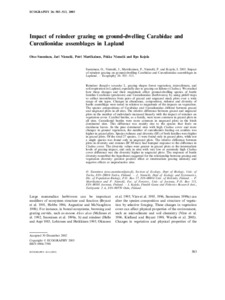Impact of reindeer grazing on ground-dwelling Carabidae and Curculionidae assemblages in Lapland
Niemela J; Niemela P; Suominen O; Kojola I; Martikainen P
Impact of reindeer grazing on ground-dwelling Carabidae and Curculionidae assemblages in Lapland
Niemela J
Niemela P
Suominen O
Kojola I
Martikainen P
BLACKWELL MUNKSGAARD
Julkaisun pysyvä osoite on:
https://urn.fi/URN:NBN:fi-fe2021042716760
https://urn.fi/URN:NBN:fi-fe2021042716760
Tiivistelmä
Reindeer Rangifer tarandus L. grazing shapes forest vegetation, microclimate, and soil respiration in Lapland, especially due to grazing on lichens (Cladina). We studied how these changes and their magnitude affect ground-dwelling species of beetle families Carabidae (predators) and Curculionidae (herbivores), by using pitfall traps to collect invertebrates from pairs of grazed and ungrazed study plots over a wide range of site types. Changes in abundance, composition, richness and diversity of beetle assemblage were tested in relation to magnitude of the impacts on vegetation. The species compositions of Carabidae and Curculionidae differed between grazed and ungrazed plots in all sites. The relative difference between grazed and ungrazed plots in the number of individuals increased linearly with the impact of reindeer on vegetation cover. Carabid beetles, as a family, were more common in grazed plots in all sites. Curculionid beetles were more common in ungrazed plots in the birch dominated sites. This difference was mainly due to the species that feeds on deciduous leaves. In the pine dominated sites with high Cladina cover and more changes in ground vegetation, the number of curculionids feeding on conifers was higher in grazed plots. Species richness and diversity (H') of both families were higher in grazed plots. Of the total 27 species, 11 were found only in grazed plots, while not a single species was found only in ungrazed plots. The relative difference between plots in diversity and evennes (H'/H' max) had humped response to the difference in Cladina cover. The diversity values were greater in grazed plots at the intermediate levels of grazing impact, and only in sites with very low or extremely high Cladina cover difference was the diversity higher in ungrazed plots. The response of beetle diversity resembled the hypotheses suggested for the relationship between grazing and vegetation diversity: greatest positive effect at intermediate grazing intensity and negative effects at unproductive sites.
Kokoelmat
- Rinnakkaistallenteet [19207]
